Oh my, China has built a lot of centrifuges for uranium enrichment in recent years.
You may know that China purchased several modules of Russian centrifuges in the 1990s, installing them at Hanzhong and Lanzhou. You may also know that China built a large facility at Lanzhou that appears to house a domestic centrifuge enrichment facility.
What you almost certainly don’t know is that China now appears to have constructed another indigenous centrifuge facility near Hanzhong. And if you did know, but didn’t tell me … well … I am sort of sore at you.
The two indigenous Chinese centrifuge facilities together represent about 700,000-800,000 SWU per year. (Centrifuge capacity is measured in separative work units or SWU.) Add that to the four Russian-supplied modules totaling 1,500,000 SWU and I think maybe URENCO should get that anti-dumping case ready.
THE CHINESE LEU IS COMING. THE CHINESE LEU IS COMING.
Details after the jump.
The Chinese have had a centrifuge program since the late 1970s. The program began in earnest in 1977. China developed a supercritical centrifuge using maraging steel in 1981 “on the basis of materials published abroad.” Apparently China made a little low enriched uranium before experiencing a period of “reorganization” in 1983-1986. AQ Khan claims he “put up a centrifuge plant” near Hanzhong sometime before 1985. Maybe he did; maybe he didn’t. It is certainly possible that the Chinese were less than impressed with his contributions, prompting the reorganization and return to the drawing board.
Ultimately the Chinese did purchase modules of centrifuges from Russia in the 1990s, the first of which were installed at Hanzhong and placed under safeguards.
Back in 2006, I found China’s safeguarded centrifuge facility near Hanzhong — the Shaanxi Uranium Enrichment Plant — in Google Earth. Until 2005, the IAEA consistently mistransliterated the place name as “Hanzhang,” but the Chinese characters were always correct. I don’t know what possessed me to double-check. Maybe because I hated my life in Cambridge. Anyway, I also found a blurry photo of the facility on the CNNC website and that was plenty.
It’s here: 33°15’42” N, 107°25’49″E
At the time, I wrote a long piece about matching the ground-truth and satellite images that I will probably never publish. (I actually got hung up on the totally irrelevant detail of the Chinese characters for Heping, the location of the gaseous diffusion plant.) Anyway, the really important details are the layout of the buildings, the pipes on the roof and the fact the name of the facility and the China National Nuclear Corporation logo are mowed into the fricking lawn. I call that high confidence.
CSEP stands for China Shaanxi Enrichment Plant. Here’s the logo for comparison.
This image is rather old — it dates to 2005. Now here is a 2012 image from Digital Globe. Notice anything different? Like two brand new giant buildings?
One is a new Russian-supplied centrifuge facility, the other is an indigenous Chinese centrifuge facility. Busy beavers.
The Russian-supplied facility was completed in 2011. It is clearly the finished building. It has a given capacity of 500,000 SWU. That’s a lot of SWU given the size of the building. It’s big, but not that big. The other Russian-supplied modules produce about 20 SWU/m2. To accommodate 500,000 SWU as advertised, this plant would have to produce nearly 28 SWU/m2.
Fear not! I notice that the General Director of TENEX, Alexey Grigoriev, toured the facility and said “It is a state-of-art, compact and truly beautiful facility where together with our Chinese comrades we have worked out not only the optimal design and technological solutions, but also the principles of efficient interaction that laid a solid foundation for implementation of new bilateral projects.”
In other words, they really jammed a lot of crap in there. Tenex also released a photo of the site, which makes my previous sleuthing totally unnecessary.
While I expected to see the new Russian facility, I did not expect to also see a smaller version of the indigenous plant at Lanzhou. The Chinese facility is the partially completed building in the back.
The indigenous centrifuge facility at Hanzhong (left) is about half the size of its sister facility at Lanzhou (right). Hanzhong has half the floorspace (two 60 m x 150 m halls instead of two 130 m x 150 m halls) and half the number of mechanical draught fans to cool the facility (8 in Hanzhong, 16 at Lanzhou). Since Lanzhou reportedly has a capacity of 500,000 SWU year, I’d tentatively call Hanzhong 250,000 SWU.
I’ve tried to make a nifty little table. One thing that I notice is there are three different clusters of efficiency: the newest Russian module with 28 SWU/m2, the first three Russian modules with 20 SWU/m2 and the two new indigenous Chinese facilities with 13-14 SWU/m2. It would seem the Chinese have a way to go before catching up with the Russians.
(Oh, one more thing. Take a close look at the new photos of the roof “E” shaped administration building. SOLAR PANELS! Hippies.)
|
China’s Gas Centrifuge Facilities |
|||||
|
Facility (Supplier) |
Dimensions (m) |
Floorspace (m2) |
Capacity (SWU) |
Columns |
Ratio of SWU:m2 |
| Hanzhong 1 (RUS) |
110 x 80 |
8,800 |
200,000 |
1,100 |
20 |
| Hanzhong 2 (RUS) |
150 x 110 |
16,500 |
300,000 |
1,700 |
18 |
| Hanzhong 3 (RUS) |
90 x 200 |
18,000 |
500,000 |
28 |
|
| Hanzhong 4 (PRC) |
60 x 150 x 2 |
18,000 |
250,000 |
14 |
|
| Lanzhou (RUS) |
320 x 80 |
25,600 |
500,000 |
2,800 |
20 |
| Lanzhou (CHI) |
130 x 150 x 2 |
39,000 |
500,000 |
13 |
|
| Building dimensions and floorspace estimates are derived from satellite imagery. The number of columns is derived from capacity (as given in Hibbs) assuming 180 SWU per column. | |||||
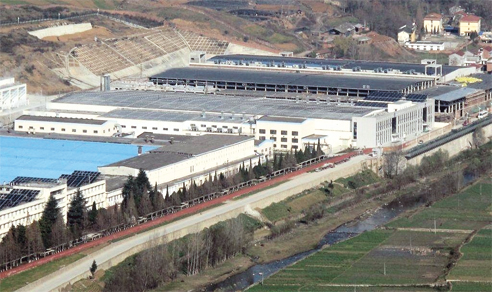

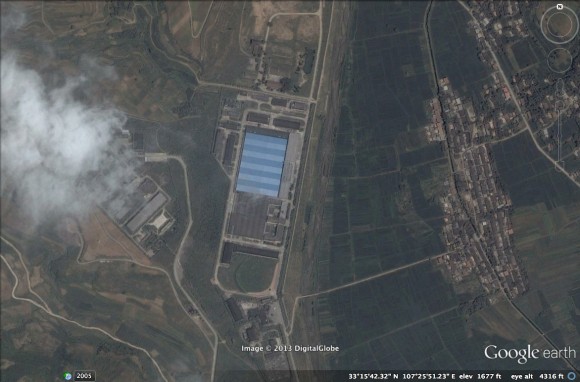
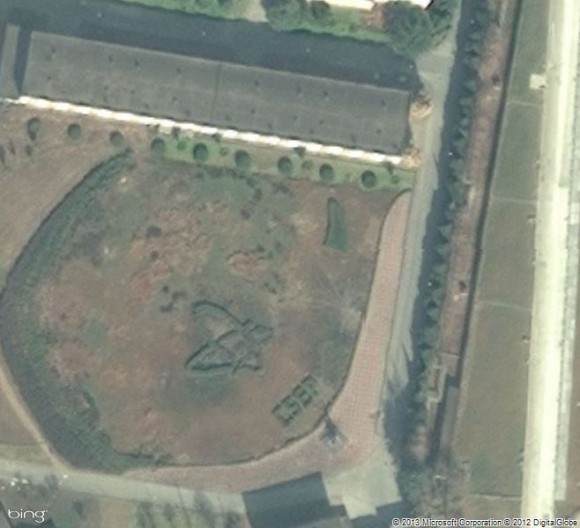

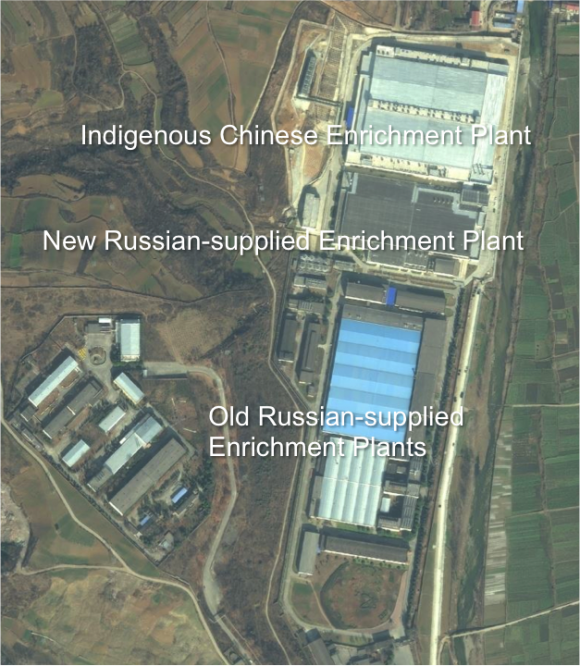
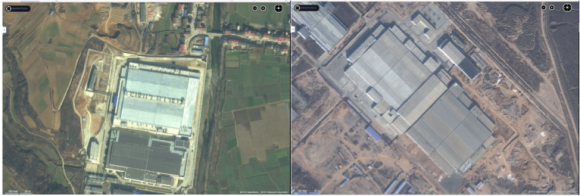

It will be a while before they can match Urenco:
http://www.urenco.com/custom/459/virtualtour/default.aspx
Depends on the definition of “match”. What matters is the cost per SWU, not the absolute performance of centrifuges. Just ask the American Centrifuge folks.
The Lanzhou plant reportedly produced its first LEU in June 2013 http://fissilematerials.org/blog/2013/06/chinas_centrifuges_produc.html. The first three Russian-built facilities use what Russia calls 6th-generation centrifuges. There was indeed a discussion of the fourth one using newer technology. What’s interesting is that the original 1991 agreement between Russia and China did not have a protection of intellectual property clause. At the same time, Russia says it never (willingly) transferred the technology to China – http://www.fissilematerials.org/blog/2010/10/china_is_believed_to_oper.html.
Are these new plants tied to Chinese nuclear weapons program? I would assume that they are.
Juuso wrote:
Are these new plants tied to Chinese nuclear weapons program? I would assume that they are.
The vast bulk of Chinese enrichment goes into electric power reactors. They currently import a lot of other people’s LEU reactor fuel…
They also have a non safeguarded weapons program, but I suspect that’s not growing as fast as reactor fuel demand. Being dependent on others for reactor fuel, as they are for oil, is undoubtedly uncomfortable.
No, they are not.
GWH is right, those factories are for electric power reactors.
No, these plants are to fuel China’s growing number of reactors as the old gaseous diffusion plants — which were converted to civilian LEU production — have reached aged.
A question of historical interest: if PRC started building nuclear weapons in the ’60s but didn’t get an enrichment facility until the late ’70s, where were they getting the material for those early weapons from?
From their gaseous diffusion plant.
Plant 504 in Lanzhou was gaseous diffusion plant, and Plant 404 in Jiuquan had Graphite Reactor and PUREX facility.
The first chinese A-bomb and H-bomb were built at Plant 404
http://www.nti.org/facilities/724/
http://www.nti.org/facilities/722/
Plant 404 suffered also some industrial accidents during 70-er, several accidents were pretty serious.
The first gaseous diffusion plant at Lanzhou was completed in time to provide HEU for the 1964 test.
China has certainly got good at building big.
Wenchang launch center: 19.639756 110.951201 and scroll Google earth photoset to the latest. Two VABs and a horizontal payload area, matching pads one with a 25 meter wide flame trench (Pad 39 is 18 meters).
Jiangnan shipyard: 31.354114, 121.737414, scrolling the photoset back to 2005 is recommended! More warships in construction now than in 2008, but interesting that the government naval yard is still 3/4 commercial. Wiki says annual shipbuilding capacity can reach 4,000,000 DWT.
Interesting. Is there any public estimate of how good their centrifuges are (e.g. can they match URENCO’s TC-21)?
They are copies of the Russian models. You can get a sense by noting the difference in SWU/m2. At 13-14 SWU/m2, the Chinese centrifuges are not nearly as efficient as mid-90s Russian models at 20 SWU/m2.
Jeffrey
In no way is this a criticism of your excellent work but throughout your text you quote numbers in SWU/m3 (your table correctly says ratio of SWU:m2).
I read your text “That’s a lot of SWU given the size of the building. . . etc” got to the number per m3 and amost spat my coffee! Thought how the f*ck, oh typo!
Dear lord. Why on earth did I put it in cubic meters?
It is better for China to make and for there to be IAEA controls on the exports to suspected nuclear weapons proliferators for use in the suspected proliferators conventional power reactors. China already has a nuclear arsenal, but 50 years into it, there is no sign that they would ever use them.
according to Mao, Nukes is “paper tiger”, Nobody will use them really.
Jeffrey, I’m losing faith in you: “the really important details are the… fact the name of the facility and the China National Nuclear Corporation logo are mowed into the fricking lawn. I call that high confidence.
No, the name and logo aren’t mowed into the lawn. You can clearly see they cast a shadow. Those are hedges. Which means there are two key questions.
First, what are they hedging? Also in that image are a sort of malformed Nike swoosh, what looks a half finished, poorly designed shrubbery Stonehenge, and some rows of trees.
Second, although their hedging efforts look amateurish, they seem to be learning fast. Are they trying to compete with us for superiority in Strategic Shrubbery? They could seize dominance soon, since DOE’s landscaping, from Hanford and Livermore to the Forrestal Building itself, looks sad. It hasn’t been state-of-the-art since 1965, if ever.
If satellite imagery some time soon shows a full-color logo done in petunias and pansies, we’ll have a full-blown Shrubbery Gap on our hands. Don’t say I didn’t warn you.
I stand corrected and warned.
Friends don’t let friends be bushwhacked!
Herring off on a bit of tangent, I think that America depends on a national militia of properly groomed shrubs across the heartland.
That’s a lot of LEU, but it makes plenty of sense given China’s energy needs, although they’re bucking the trend a bit.
Monty Python’s Shrubbery Gap:
http://www.youtube.com/watch?v=2xvvvJ7hvo8
ACW at its best.
MK
Under its Voluntary Offer Safeguards agreement China has put the enrichment facilities in Lanzhou and Shaanxi on the list of facilities, which the IAEA can pick for safeguards. However, the facilities subject to this offer are only those, which were built by the Russians. The IAEA, Russia and China used the Shaanxi plant to develop, in the tripartite safeguards project, an approach for safeguards for the Russian centrifuge technology. Some elements of the approach are used to day e.g. in Brazil and Iran. With regard to the square meter debate, it may not be so bad to use cubic meters; Russian centrifuges are in layers and thus the height matters. When you try to estimate a capacity of the older plants, it is important also to remember that the buildings were originally designed for the diffusion plants. Thus sizes of old buildings might not be optimal for a centrifuge plant. Having said that, they are all pretty tightly packed inside.
In the original paper, which was before the appearance indigenous facilities, I noted the height of the columns.
This is actually a serious source of uncertainty. If the Chinese simply stack their centrifuges taller, the overall configuration might be more compact in terms of square meters.
According to Urenco, Capenhurst Building E23 Houses more than 80% of site’s enrichment capacity.
Capenhurst capacity 5050tSW/a
E23 area 200*600 m= 120000 sq.m.
Therefore E23 capacity should be around 33.63 SWUa/m2.
Declassified 1964 Photo Interpretation Report describes two reactor sites – possible (earlier construction, associated with chemical separation plant) and probable (usually referred to as the reactor). Any comments?
They were wrong about Baotou.
While it is widely presumed that China copied the Russian design, I’ve always felt some skepticism about this assumption is warranted. The Chinese centrifuge literati are not to be sneezed at and, in my view, perfectly capable of design their own centrifuges. China has a long history of centrifuge development dating back to before the Sino-Soviet split. In 1970, US intelligence estimated that China had received substantial knowledge from the original Soviet centrifuge engineers, but their research continued even after the split, during which time they produced probably three early designs. After the cultural revolution, the program was revived. It did original design research (some based out of Tsinghua University) and established a large cadre of engineers inside the State-owned company. There were also some connections with the Khan network, which suggest they may have received CNOR, G-2, and/or 4M design information in exchange for uranium and manufacturing assistance. Thus, while I don’t doubt that the Russian machines will have had their influence on Chinese thinking, I suspect the Chinese designs—which they call Xuan Feng-1 and Xuan Feng-2—could integrate a range of foreign and indigenous technical ideas.
From the perspective of square footage, the facility at Lanzhou is 25,600 m2.
If we assume a URENCO like case, with a rule of thumb of one centrifuge per square meter and a total capacity of 500,000 SWU, that would work out to about 20 SWU per machine. That is twice as good as Brazil but maybe half as good as URENCO.
If we assume a Russia like case, assuming one module per 8 square meters, the Chinese case works out to about 100 SWU per column — more than half as good as the generation of centrifuges sold by Russia (180 SWU/column)
I guess it is hard on this basis to infer which is more likely. I have a dim recollection of being told the centrifuges at Lanzho were Russian-like, but I might be imagining that. The Russia case seems a little more probable to me, although I wouldn’t bet my life on it.
Jeff, thanks for comment on another subject, but:
I meant two suspected reactor sites at 404 Plant.
Oh, sorry. I believe the “small possible reactor building” in the August 1964 NPIC report is a misidentification of the the component manufacturing factory, including the machine shop where the uranium hemisphere were machined.
The Chinese might have started by using russian centrifuge design but it seems by now that they have developed an indigenous design…
http://www.world-nuclear-news.org/ENF-China_builds_uranium_enrichment_centrifuge-2502134.html
Furthermore, I somewhere read that their length are between Urenco’s 3m (TC-21) and the russian’s < 1m (8th generation)which does not completely fit with the assumption of a simple "copycat" design…
Will try to find the source…
I am not sure it makes sense to imagine a compromise between the two approaches — modules of small subcritical centrifuges or larger URENCO-like supercritical centrifuges. They are apples and oranges as far as I can tell.
The Chinese certainly developed large supercritical centrifuges in the late 1970s-early 1980s, at the same time they are alleged to have received assistance from AQ Khan that related to the P1. But then they went through a period of reorganization and bought Russian. (I thought the 8th Gen machines were still subcritical and represent the technology more or less maxed out.)
Anyway, I’d love to see the source suggesting it is something in between. Who knows what they’ve actually built.
is it possible to comment this including video:
http://mil.news.sina.com.cn/2013-06-24/0802729071.html